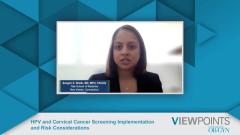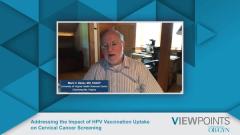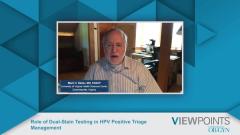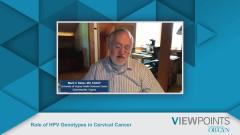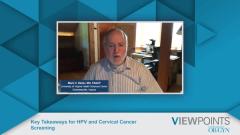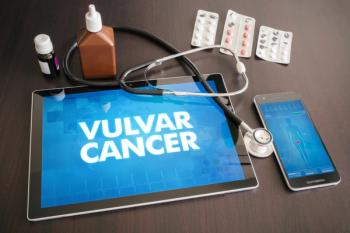
Role of HPV Screening and Vaccination for Cervical Cancer
Emily K. Hill, MD; Sangini S. Sheth, MD, MPH, FACOG, and Mark. H. Stoler, MD, FASCP, review the rationale of screening for HPV and vaccinating patients to prevent progression to cervical cancer.
Episodes in this series

Dr Thomas C Wright Jr: Welcome to this Contemporary OB/GYN presentation entitled "Expert Perspectives on Advances in Cervical Cancer Screening." I am Tom Wright. I am a pathologist in the New York area. I’m joined by Dr Emily Hill, a Clinical Associate Professor of Obstetrics and Gynecology and Gynecologic Oncology at the University of Iowa; Dr Sheth who is an Associate Professor of Obstetrics, Gynecology, and Reproductive Sciences and is the Associate Chief of Gynecological Specialties at the Yale School of Medicine; and Dr Mark Stoler, a Professor Emeritus of Pathology and Clinical Obstetrics and Gynecology at the University of Virginia. The discussion today is going to focus on various clinical factors that inform the testing and screening for cervical cancer. We’ll look at available screening options and evolving guidelines, and we will also discuss future considerations and practicalities with respect to cervical cancer screening. Welcome, everyone. I'm looking for a free-ranging discussion today. The first area that we want to discuss is cervical cancer screening awareness. By way of just very briefly going into the role of HPV in the pathology of cervical cancer, Dr Stoler, do you want to give 1 minute about the types of HPV and the rationale for screening for HPV for cervical cancer screening?
Dr Mark H. Stoler: Sure, Tom. In 1 minute, we know that cervical cancer in many parts of the world where there isn't screening is still the number 1 or 2 cancer killer of women in contrast to countries like the United States and other countries that have had cervical cancer, for now 40, 50, or 60 years. Perhaps screening has greatly reduced the incidence of cervical cancer, but as the incidence has fallen, which drives the performance of any screening test, the performance of the pap [smear] has slipped so to speak. We know that virtually all cervical cancer, squamous, adeno, small cell, virtually all histologies with few exceptions are due to high-risk HPV-driven transformation of the cells and the cervix and that is why HPV screening is so critical to cervical cancer screening performance. HPV testing is much more sensitive than pap screening. That increased sensitivity has allowed us to screen at longer intervals and much more effectively than we used to do with annual pap screening. We screen molecularly with clinically valid HPV tests that test for between 13 and 15 high-risk HPV types. Those 13 to 15 types account for more than 95% of all cervical cancers. It's that high sensitivity that reassures the 85% or 90% of women who are negative in any screening realm that they are safe and don't have a risk of developing cervical cancer in the next three to five years.
Dr Thomas C Wright Jr: That's great, Mark. Now, the purpose of screening is to identify pre-cancers as opposed to identifying the invasive lesion. Dr Hill, could you address how long it takes to go from a CIN 3 lesion to an invasive cervical cancer or preferably even a CIN 2 lesion?
Dr Emily K. Hill: I think one of the reasons that we've had such success with cervical cancer screening is because of the latency period that it takes for an HPV infection to cause high-grade precancer or cancer. We find that the majority of women are going to clear these viruses within probably 6 to 18 months of getting them. The women that we're worried about are the women that hang on to the virus in their genital tract, and it's there for long enough to cause problems. I think that you've got to give a range in terms of how quickly these viruses can cause cancer. I think in immunocompromised women and some [other] women, it can be more on the range of 5 to 10 years, but I think in an immunocompetent patient or woman, it could be more like 10 to 20 years. It really is a slow process, and that's why we have the opportunity to intervene before these viruses are able to cause invasive cancer.
Dr Thomas C Wright Jr: Dr Sheth, we live in a different world than we did 10 years ago since we have vaccination against HPV. Where are we in the United States with respect to HPV vaccination rates?
Dr Sangini S. Sheth: The good news is their rates continue to get better. Unfortunately, we're far still from optimal levels which would really be among adolescents reaching 90% or higher vaccination rates. Among our 13 to 17 year olds, our rates are getting at least one vaccine dose on board; we're probably around 60%. Because this is a multi-dose vaccine where everyone needs to have had 2 to 3 doses to be fully vaccinated, being completely vaccinated, we're lagging even more. The complete vaccinated rate is more like 40% to 50%. There's still a lot of room for improvement starting at age 9 and then moving up in some situations up through even age 45.
Dr Thomas C Wright Jr: The 2 to 3 doses: my understanding is it is 2 doses if you initiate vaccination before age 15 and 3 doses after. Is that correct?
Dr Sangini S. Sheth: Yes, absolutely. All the more reasons to vaccinate early because then it's 2 doses.
TRANSCRIPT EDITED FOR CLARITY
Newsletter
Get the latest clinical updates, case studies, and expert commentary in obstetric and gynecologic care. Sign up now to stay informed.



